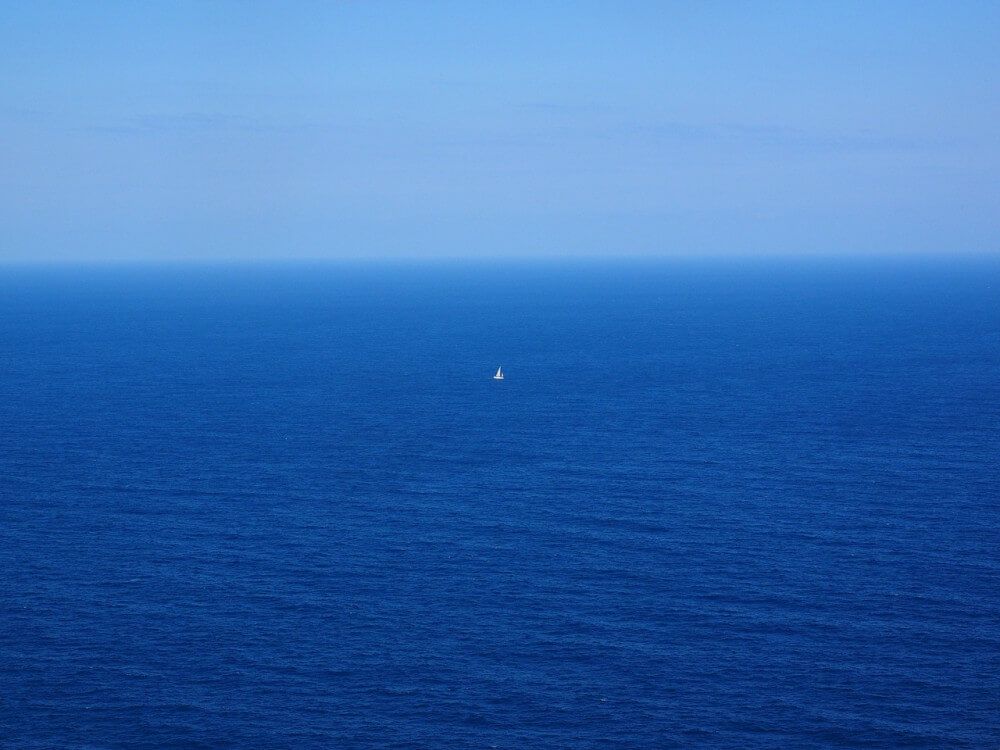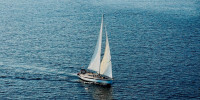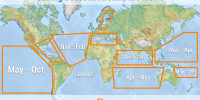What Is Bluewater Sailing?
It's easy to confuse offshore sailing with bluewater sailing - and it's no wonder. Many people do, including myself. So I've decided to list the difference once and for all in this post.
What is bluewater sailing? Bluewater sailing is a type of ocean cruising: it refers to long term open sea cruising, for example passages (ocean crossings). Bluewater sailing implies a lack of support and requires a certain amount of self sufficiency, since you're away from land for long periods of time. An example is crossing the Atlantic.
But you can't just stock up any boat and go at it: not all boats can handle 'blue water'. You need a different boat type and also some add-ons. So before crossing the Atlantic, make sure to read on.

Different Types of Cruising
You can sail on any kind of water, really: rivers, lakes, oceans. Each type of water has its own challenges and difficulties, and some are harder to master than others. Most people only sail inland or coastal waters and stay well within reach of the Coast Guard.
Bluewater sailing is a type of ocean sailing that requires a lot of extra skills and equipment. Crossing an ocean requires a lot of prepping and planning, and maybe even a different boat. You should plan on not seeing harbor for multiple weeks.
Here are the different types of sailing:
- Inland
- Estuary - rivers that lead to sea
- Coastal - in sight of land
- Off Shore - out of sight of land
- Ocean - blue water
The easiest sailing is on inland waters. Freshwater lakes and rivers are pretty safe. There are more people around that can help you out and the water conditions are more predictable.
Estuary (tidal mouth of a river) and coastal sailing also has a lot of oversight. With the Coast Guard keeping a close eye on everybody, the chance that something really bad happens is extremely small.
Offshore sailing can be the most difficult. You're sailing offshore when you can't see the coast anymore, but you're also not crossing an ocean or something like that. Sea conditions can get very rough: the weather gets more unpredictable where land meets water, and the current can get very strong. A mistake can have huge consequences. Offshore is being watched pretty closely by the Coast Guard as well, so if something goes wrong, help will be underway.
Blue water sailing is one of the most advanced types of sailing. It's hard simply because you have to be self-reliable. You're out on the open ocean alone, sometimes for two or three weeks. It can get pretty rough. If anything breaks, you need to be able to fix it. If something goes wrong, you need to solve it. The stress can be intense, and plenty of people break down because of it. But plenty of people also toughen up (maybe after first breaking down).
Difference Between Bluewater and Offshore
So where exactly is the line between offshore and blue water? It's hard to say. There is of course a grey area (pun intended). I'd say that offshore sailing is when you plan on returning to the same port, or getting to a port in the same coastal region. If you're planning on crossing a large ocean to arrive in a port in a different coastal region, or another continent, that's definitely bluewater.
A good rule of thumb is that it's probably bluewater if there's some sort of crossing involved.
Other sailors say that it comes down to the amount of support you can expect. No support = bluewater. You simply have to deal with whatever the water throws at you.
As long as the Coast Guard comes to get you when there's trouble, and you don't have to fix it yourself, it's offshore sailing and not bluewater.
What's the difference between bluewater and offshore sailing? The difference is the voyage length and place of arrival. If you plan to return to the same port or arrive in the same coastal region, we speak of offshore sailing. If you cross an ocean and arrive in a different coastal region, or on another continent, we speak of bluewater sailing.
So the type of sailing is determined by the water you're on, but also your intentions.
What is a Blue Water Sailboat?
A blue water sailboat is a boat that is designed for extended voyages in open water. The opposite are inland production boats. Blue water boats and production boats differ in a couple of ways. In this post I'm talking about monohull sailboats, and not multihulls or powerboats. So I'll leave catamarans and trimarans out of the discussion (however cool they are).
Blue water boats are stronger, more stable, generally longer, and a bit slower. Production boats are cheaper, more lightweight, sometimes faster, and generally shorter.
The difference between a blue water and inland sailboat is the production method, hull type and shape, material, and general safety and quality of the boat. The most important aspect of ocean sailing is a strong hull. You need a very reliable one, as this is your only line of defense. Most production boats are made of aluminum and are spot-welded together. So there not super strong.
The hull of a blue water boat is most likely made of fiberglass instead of aluminum. This makes them a lot stronger and more durable. This is important to deal with the enormous forces that are pounding it in rough weather. Larger waves and stronger currents all add to the stress on the boat. Other materials are used as well, like wood, aluminum (better welded), steel, and so on. Fiberglass is your safest bet though.
A blue water sailboat has a displacement hull with a keel (fin). The keel increases the stability a lot. Because of this, the boat will be able to hold up in larger waves. It reduces the risk of capsizing. It also increases the draw, making the boat less suitable for shallow waters.
The boat needs to be longer to deal with longer waves, but also to provide enough storage space for supplies and equipment. A longer boat generally is faster. If you want to learn more on the link between hull length and speed, read my nerd post about it here (I'm proud of it).
They also use better quality rigging and sails, to keep up with the stronger winds.
Another important feature in blue water boats is the systems that are used to deal with saltwater. Salt causes galvanic corrosion, which eats away at aluminum and steel parts. So the boat needs to be outfitted with a different cooling system and parts to offset this corrosion.
A bluewater sailboat most likely has an inboard engine with full closed cooling system. It also has a Mercathode system with sacrificial anodes.
If you want to know more about the difference between fresh and saltwater boats, you should definitely check out my article here (opens in new tab).
What Do You Need for Blue Water Sailing?
The most important thing is supplies: your boat needs to be able to carry lots of freshwater and fuel for long-range cruising. People that do serious blue water sailing will carry large freshwater tanks that will last them at least three week. You need water for drinking, but also for cooking and washing.
In general you need roughly 5 liters of water per person per day. You want to be able to last three weeks. If you're crossing oceans, you want to double that, just to be safe. So we're talking about 240 - 480 liters of water for a three week trip (about 50 - 100 gallons).
They'll also carry plenty of extra fuel for emergencies. If you need to get out of there (for example hurricanes coming up) you don't want to wait for the wind to come around. You just want to start that engine and GO. Typically you carry enough fuel to go for about 500 nautical miles. This is about 240 liters (60 gallons) of fuel for an average mid-sized engine.
Supplies and systems you need:
- plenty of freshwater
- plenty of fuel
- autopilot (definitely)
- a water maker (to filter saltwater into fresh drinking water)
- a fridge or freezer
- all kinds of safety gear
- marine communications (HF Radio)
- marine navigation equipment (radar)
- forward scanning sonar
- two anchors (at least)
If you want to learn more on how to choose your marine navigation equipment, head over to the recommended gear section of this website:
If you're interested in how to convert your freshwater sailboat for saltwater, I've previously written an in-depth article on it. I'm proud of it, it's a good read. You can check it out here.
Related Questions
What is offshore sailing? Offshore sailing is sailing on open seas, out of sight of land, with the intention of returning to the same harbor (or another in the same coastal region). You stay within reach of Coast Guard assistance (5-15 NM from shore). You need an appropriate boat for offshore sailing, with a strong enough hull and a keel.
Did you find the answer to your specific question?
👍 35 👎 2



Comments
Glynn Erasmus
Hi Shawn
Informative article. I am in South Africa, not a sailor as such (have done windsurfing), but have been looking at boats with a view to living on one, for reasons of accommodation costs. I would like your thoughts, if possible, on whether this boat, currently in your part of the world if you are still in the Netherlands, could make a trip down to South Africa, bearing in mind some of the conditions around Cape Town, and I suppose because it is not really, as far as I understand, a blue water type boat. https://www.scheepsmakelaardijgoliath.nl/schepen-aanbod-detail/162371/zeilsloep-900/
Thanks
Paul Fitz
I have always loved the sea but only experience it from shore a very healthy respect for it, since lockdown i stubbled into sailing after watching a true event video of a saleboat capsize and 4 day survival , so you could say i started from the worst sinario and now i’m hooked, I can’t think of anything else, i eat sleep and sh*# sailing from beginners to avanced sailors , i don’t have a boat or means to get one yet , but the fire is lit.
Best regards Paul Fitz
Dave Evans
Hi Shawn,
You know the feeling when, occasionally, you discover a site or videos that you anticipate devouring like a ravenous crocodile? Well for me this is one of those happy times.
I’ve work to attend to today but will be counting the minutes until I’m back home enjoying your site and Youtube videos.
I’m 62, a very interested novice who has never sailed, but who’s desperate to start, ultimately to the point of crossing the Atlantic solo. I love to spend long periods alone and relish the chance to put my solitary nature and self-reliance to good use.
I’m searching for a little ‘project’ blue water boat around 25 to 30 feet, and have a lifetime of carpentry, plumbing, electrical and metalwork skills waiting to be used. I’d like a full-length keel if I can find one as I like the way the rudder is protected.
Bless you for taking the time and effort to publish all this information - I just read this blue water boat article and now can’t wait to get stuck in to more this evening.
Best wishes,
Dave.
Leave a comment